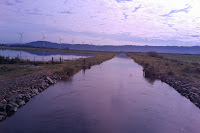Itaipu Dam/ Hydroelectric Power Plant
This was the last full day of our trip, so naturally we had to cram as much in as possible. The morning started out with a trip to a farm which runs exclusively on biogas from animal waste. From there, we traveled to Itaipu Dam, one of the largest hydroelectric power plants in the world.
Farm visit: Fazenda Colombari
This family owned farm makes their money growing pigs and cattle to be shipped off for slaughter. These livestock produce a great deal of... waste. That's where CIBiogás comes in. CIBiogás is a Brazilian company which installs and operates biodigesters on farms to produce fuel (mostly methane) to run these farms. On our farm visit, the biodegster only ran off of pig waste, due to its shorter digestion time (the digester can process pig manure in 28 days whereas cattle manure takes 32 days to fully break down). The cattle manure isn't wasted though, as it is used as fertilizer on this farm and other local farms. Additionally, pigs produce much more waste in regards to their body size, kicking out 10 L of manure per pig per day. This manure is high in hydrogen sulfide, a highly corrosive gas which must be removed prior to biodigestion (HS2 is what gives manure that rotten egg smell).
The biodegster itself is a pretty well engineered system. The base is a large trapezoidal trough, covered in high density polyethylene (HDPE) to prevent infiltration of the liquid waste into the ground. At one end, treated pig waste flows into the biodegester, and at the other end, a watery effluent flows out at the same rate. Bacteria in the tank break the organic matter into methane and carbon dioxide, which rises above the liquid to be collected. The effluent flows out, to be used as fertilizer, and the gas is sent to a 140 kVA (kilovolt-amperes) generator, producing 0.4 MW to power the farm. This treated biogas is much better for the environment than straight burning of manure as fuel, releasing 26 times less pollutants into the atmosphere.
Itaipu Dam
The Stone that Sings
Built on the Paran[a] river between Brazil and Parguay, Itaipu Dam was, until very recently, the largest power station in the world (Three Gorges Dam in China took over that distinction in 2014). The ownership of the plant is split 50/50 by Brazil and Parguay, although the Dam itself technically sits on neither of their land. When the construction began in 1975, both countries agreed to share the land, making it a neutral area where both peoples could work towards their common goal. Construction was finally finished in 2007, with the completion of the 20th generator (18a, on the right bank - the "Brazilian" side). Itaipu now operates 20 generators, half operating at 60 Hz (to supply Brazil with power) and half operating at 50 Hz (to supply Paraguay). This level of cooperation extends to the workers too, half of which are Brazilian, and half are Paraguayan. All signs and documents are printed in Portuguese, Spanish, and English. English is used as a neutral language in case the need arises. This partnership between Brazil and Parguay will continue until 2023, at which time the dam will have been paid off, allowing each country to do what it wants with it's portion of the dam.
Design Details
The main dam is a 196 m tall, 612 m long, hollow trapezoidal structure with wall that are 20m thick at the base and taper to 14 m thick at the top. This main dam was constructed with ice-cured concrete, supplied by an onsite ice factory (it was removed once concrete activities were completed). The reservoir behind the dam is held in place by a 1,98 4m long rockfill dam, a 1,438 m long buttress, and two earthfill dams, one stretching 2,294 m and the other of 872 m in length. There is also a spillway structure, opened when the reservoir gets too high. These gates are only needed for 10 days out of the year (more if there is a particularly rainy season). Water flows through 20 8-m diameter pipes located 23m below the top of the dam. These pipes drop the water into generators, each one supplying 1,400 m3/s to the 715 MW turbines. The generators never hit this maximum wattage, averaging closer 675 MW, with a peak of 700 MW. Each turbine is closed once per year for maintenence.
The structure was built with a design life of 60 years, although the main concern is the integrity of the reservoir, which is estimated to last until 2140.











































